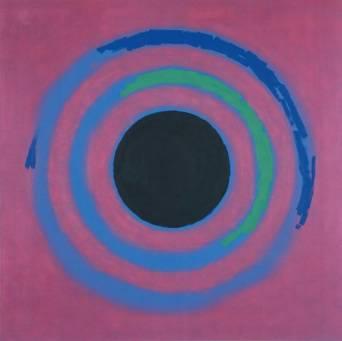Kenneth Noland
dal 20/11/2004 al 6/3/2005
Segnalato da
20/11/2004
Kenneth Noland
Museum of Fine Arts MFAH, Houston
The Nature of Color

Surveying over four decades of American painter Kenneth Noland's career, ranging from 1959 to the artist's current studio production, the Museum of Fine Arts, Houston presents Kenneth Noland: The Nature of Color, opening November 21. The exhibition features approximately 25 paintings, with examples from the MFAH's collection establishing the core segment of the show. The remaining works in the exhibition are on loan from Houston collections and from the artist's studio. While not a full-scale retrospective, this survey highlights Noland's transformation of the history of Modernism, demonstrating the extraordinary level of invention, exploration, and renewal he brought to American painting.
The optical sensation of color is the primary subject of Kenneth Noland's work. ''I wanted color to be the origin of painting,'' the artist has stated. A seminal figure of Color Field Painting in the late 1950s, Noland balances strict formalism with powerful lyrical expression throughout his work. The organization of the exhibition reflects the serial nature of Noland's practice, beginning with his early Circle series paintings and continuing through his most recent Mysteries series. The installation emphasizes the vitality and power of the artist's willingness to revisit, expand, and transform compositional strategies.
''The Museum of Fine Arts, Houston is honored to have this opportunity to create this overview of Kenneth Noland's masterpieces,'' said Peter C. Marzio, MFAH director. ''Looking back at the last half of the twentieth century, we can recognize Noland's enormous talent and see how his work shaped the history of American painting.''
''This project would not be possible without the active participation of Kenneth Noland,'' added Alison de Lima Greene, MFAH curator of modern and contemporary art. ''He enthusiastically opened his archives to the museum's staff and has been a partner in every step of the exhibition's conception and presentation.''
In his Circle series of the late 1950s and early 1960s, Noland established his ''stain'' painting technique, saturating the canvas with the newly available medium of acrylic paint. This technique allowed Noland to achieve a fresh color vibrancy. Working from the center outward, Noland created an intuitive dynamic in each painting in this series, varying the measure of each band in concentric circles, opposing warm and cool tones, and contrasting contained and painterly gestures. The earliest works in the Circle series are the most improvisatory, whereas the later examples radiate a purist restraint and confidence while retaining the freshness of new work. A highlight of this segment of the exhibition will be the MFAH's celebrated Half (1959).
Noland's next important series, the Diamond and Chevron paintings of the mid-1960s, focuses on strong diagonal thrusts and forceful compositions that test the limits of the frame. In the Diamond series, Noland rotated his square canvases 45 degrees so that they became diamond-shaped, giving his work a fresh format as he animated his compositions with stripes and ''V''-shaped patterns. The closely related Chevrons consist of a sequence of evenly spaced ''V''-shaped bands which transverse the composition, reaching toward but not touching the margin of the frame, thus introducing a new sense of tension into his work.
Noland began his Stripes series in the late 1960s. Among the artist's most serene works, these paintings offer a perfect unity between the horizontal lines which run across the canvas and the long, narrow format of the compositions. Two outstanding recent gifts to the MFAH, Streak (1968) and Hush (1969), will be featured as a part of this segment of the exhibition.
By the 1970s, Noland became increasingly fascinated with challenging ideas of abstraction and decoration. In his Plaid series of the early 1970s he wove together vertical and horizontal stripes, using overlapping colors to give his work a new sense of depth. Noland's extended series of Rough Chevrons revisits the Chevron compositions from two decades earlier. However, whereas the 1960s series paintings exude a classical purity, the Rough Chevrons are deliberately volatile, with dense layers of paint and acrylic gel establishing a tactile presence.
In his work of the 1990s Noland explored the space between painting and sculpture. Dream Tune (1990) from Noland's Door series, another recent gift to the MFAH's collection, introduces this aspect of his career. With this series Noland breaks his compositions into separate panels dominated by blocks of color. Stacked vertically, the work has a flat, seemingly impenetrable surface, suggesting a psychological tautness and physical closure.
Noland's most recent work returns to the Circle themes of the 1950s. The MFAH's Lasting Eye of 1998 typifies Noland's reconsideration and transformation of the format. Where the earlier Circle paintings emphasized the material of the canvas, the later series are built up in layers of acrylic pigment like sculptural reliefs. Thus Noland adds to the optical dynamics of color the physical shifts of actual form. The exhibition closes with a selection from the Mysteries series, in which the artist has used thin layers of airbrushed pigments, directly applied paint, and unusual color harmonies to create works of uncommon beauty. As the series title suggests, these paintings explore the mystery of color and how it haunts our imagination.
For Noland, art remains an ongoing dialogue. ''When you look at a great painting,'' he says, ''it's like a conversation. It has questions for you. It raises questions in you.'' Kenneth Noland: The Nature of Color measures Noland's brilliant achievement across his career, a career that never rested, but always pushed toward new questions and resolutions.



